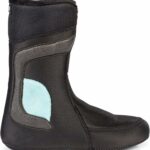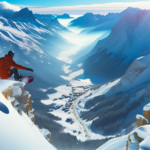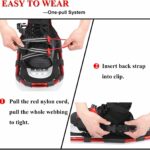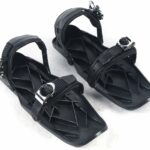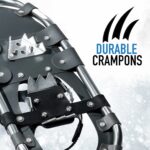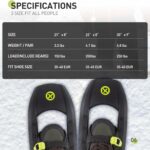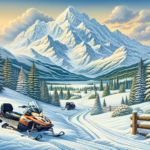Stepping out into the crisp winter landscape, you can’t help but eye the snazzy snowmobile parked nearby, just waiting for a thrilling ride. But wait a minute! How exactly do you bring this cold weather beast to life? ‘How Do You Turn On A Snowmobile?’ is an article that will guide you through the easy process of kickstarting your snowmobile, ensuring you’re zipping through the snowy fields in no time. Forget fumbling around in the cold, this clear and straightforward guide will ignite your snowmobile adventures swiftly and safely.
Understanding Your Snowmobile
Engaging in snowmobile activities can be exhilarating. Before hopping onto this package of mechanical marvel, it’s crucial for you to understand its components. This will help you to safely and efficiently operate your snowmobile and increase your enjoyment in the great outdoors.
Parts of the Snowmobile
A snowmobile is composed of several major parts. The propulsion system is a significant component and includes the engine, clutch, drive belts, and track. The chassis or frame of the snowmobile provides structure and support while the suspension system allows for a smoother ride in rough conditions. The skis at the front provide direction and stability.
Safety Features of the Snowmobile
Like any motorized vehicle, the design of a snowmobile also incorporates various safety features. Brake systems are a primary safety component to allow drivers to safely slow down and stop. Hand guards provide protection for the rider’s hands, while windshields can protect against wind, snow, and debris. Reflective decals can also enhance visibility in low light conditions.
Checking the Snowmobile Pre-Start
A pre-start check is essential before you hit the snow. This critical step can prevent accidents and unnecessary damage.
Evaluating Your Environment
Before you start your snowmobile, it’s important to assess your environment. Look for any potential hazards such as ice, rocks, or tree branches that may hinder your ride. Keep an eye on the weather forecast as well – sudden changes could affect your safety and overall experience.
Inspecting for Damage
Look over your snowmobile for any visible signs of wear or damage. Check your track, the suspension, and the skis for any cracks, tears, or breaks.
Checking the Snowmobile’s Fuel and Oil Levels
Inspect the fuel and oil levels of your snowmobile. Having sufficient, high-quality fuel and oil is essential for a smooth, steady ride.
Putting on Your Safety Gear
Safety should always be your top priority. Dressing appropriately can protect you from the harsh elements, and reduce the severity of potential accidents.
Helmets and Goggles
A helmet is a must-have for all snowmobile riders. Choose a helmet that fits you perfectly, providing some insulation without compromising your vision or comfort. Moreover, pair it with goggles that can protect your eyes from wind, snow, and debris.
Snowmobile Jackets and Pants
When choosing snowmobile jackets and pants, look for those with good insulation. These clothing items should keep you warm, while also delivering a good amount of breathability. They should also be waterproof to preserve your warmth even in wet conditions.
Hand and Foot Protection
Look for high-quality gloves that will keep your hands warm, and enable a firm grip on the handles. In terms of foot protection, snowmobile boots should provide maximum insulation, be waterproof, and also offer good grip.
Positioning Yourself to Start the Snowmobile
Proper body positioning is key to controlling your snowmobile effectively and safely.
Correct Seating Position
Sit up straight with your feet flat on the running boards. Your knees should be slightly bent and relaxed.
Placing Your Hands Correctly
Your hands should be firmly gripping the handlebars. Keep your thumbs around the grips, with your fingers easy access to the control switches.
Getting Familiar with the Controls
Before you start your snowmobile, familiarising yourself with the controls is vital.
Where is the Ignition Switch?
The ignition switch is usually located on the center console or sometimes on the right side of the handlebars. It mostly has three positions: off, run, and start.
Identifying the Throttle and Brake
The throttle, which controls the speed of the snowmobile, is found on the right side of the handlebar. The brake lever, which stops or slows the snowmobile, is generally located on the left.
Understanding the Function of the Kill Switch
The kill switch, also found on the handlebars, instantly cuts power to the engine when activated. Make sure you know its location and how to use it in case of an emergency.
Turning on the Snowmobile
Turning on the snowmobile is straightforward once you’re familiar with the controls and your gear is on.
Inserting the Key into the Ignition
Place the key into the ignition switch and turn it to the ‘run’ or ‘on’ position.
Switching on the Snowmobile
Before you start the engine, make sure the kill switch is in the ‘run’ or ‘on’ position. Then push the start button or pull the starter cord to start the engine.
Starting the Engine
After turning on the snowmobile, your next step is starting the engine.
Starting a Warm Engine
If your snowmobile engine is already warm, you typically won’t need to use the choke. Just flip the ignition switch and press the start button or pull the starter cord.
Starting a Cold Engine
For a cold engine, you’ll likely have to utilize the choke. Set the choke to the ‘on’ or ‘full’ position before turning the key and pressing the start button or pulling the starter cord.
What to Do if the Engine Doesn’t Start
If the engine doesn’t turn over, check your fuel and oil levels. You might also need to inspect the battery and starter cord. Recheck that the kill switch is in the ‘run’ or ‘on’ position. If you’re unable to identify the issue, then it’s best to consult with a professional.
Adjusting the Settings
Once the engine is running, it’s time to adjust your settings.
Setting the Idle Speed
Make sure your snowmobile is idling at the correct speed. This is usually indicated in the user’s manual. An idling speed that’s too fast or too slow can cause various problems.
Adjustment of Headlights and Taillights
Adjust the angle and intensity of your headlights and taillights according to the time of your ride and the visibility conditions. It’s important to be visible to other riders and to clearly see the trail ahead.
Testing the Snowmobile After Start Up
Testing your controls is a vital step before you hit the trail.
Checking the Throttle Response
Test the response of the throttle to ensure it’s smooth and working properly. It should spring back when released.
Testing the Brake
Before you take off, also test the brakes to ensure they’re stopping the snowmobile effectively.
Testing the Steering and Suspension
Lastly, test the steering and suspension for a smooth and responsive ride.
Common Problems and Troubleshooting
Regardless of how well you maintain your snowmobile, issues might still arise. Here’s how to troubleshoot the most common problems.
Dealing with a Dead Battery
If you have trouble starting the engine and find that the battery is dead, charge it up. If the battery is old, you might have to replace it.
Problems with the Starter
If you’re having trouble with the starter, ensure that the snowmobile is in neutral and that the brake is fully engaged. If problems persist, you might need to replace the starter.
Troubleshooting a Lilting Engine
If you hear odd noises or the engine lags in response to the throttle, this could mean a carburetor issue. Try adjusting the choke or the carb. If that doesn’t help, you might have to clean or replace the carburetor.
Always remember, when in doubt, it’s best to seek assistance from a professional. After all, safety should always come first. Happy riding!
- What Snowboard Bindings Should I Get? - January 23, 2024
- What Size Screws For Snowboard Bindings? - January 23, 2024
- How To Snowmobile On Water? - January 23, 2024

